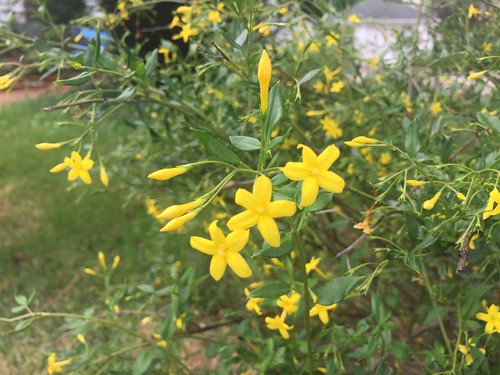Resource Library
Plant of the Week: Showy Jasmine
The best gardens are those that have little surprises tucked here and there amongst the more common and expected plants. These unexpected plants need not be big and gaudy to garner attention, only interesting. Showy jasmine, Jasminum floridum, is a late blooming jasmine that always surprises and delights me when I finding it blooming amongst more common plants.
Jasmines are a diverse group of about 200 species in the olive family scattered throughout southern Europe, Asia and India that can’t decide if they want to be shrubs, sprawling vines or climbers. Most, given their distribution in milder parts of the world, are not winter hardy north of zone 8 but a few – including the widely grown winter jasmine (J. nudiflorum) – are hardy through zone 6. The tender, but highly fragrant, white-flowered climbers such as J. officinale have been grown for centuries and is the source the jasmine fragrance used in the perfume industry.
Showy jasmine is native to southern and western China and some of the “stans” of Central Asia. It grows as a mounded, semi-evergreen shrub 3-5 feet tall and wide with alternate, glossy-green compound leaves that have three (sometimes five) leaflets. Out of flower, showy jasmine could be confused with winter jasmine but that species has opposite leaves that are not as glossy.
Clusters of yellow, five-petaled trumpet shaped blooms begin appearing in late spring and into early summer in terminal clusters. The flowers open over an extended period and are separated from other yellow-flowered jasmines by having the floral tube slightly longer than the petals. The blooms lack fragrance.
Showy jasmine was first collected by Alexander von Bunge (1803 – 1890), a Russian professor who botanized in western China between 1830-1832. He described J. floridum (which means flowery) in 1833, more than a decade before the more common winter jasmine was introduced and described in England. Showy jasmine was growing in the Earl of Ilchester’s English garden before 1842, but the more famous plant collector, Robert Fortune – who is credited with introducing winter jasmine – did not show up in China until the spring of 1843.
Showy jasmine blooms when in full leaf, so the overall effect is more subdued than the in-your-face display of winter jasmine blooming on a snowy February day. But showy jasmine has a subtle refinement that makes it fit nicely amongst other shrubs in the border. It can be planted as a free-standing shrub, located where it will cascade over a wall, or a trellis can be built to support it against a wall to create an informal espalier.
This jasmine is often listed as hardy only as far north as zone 7, but I have watched the same shrub bloom in downtown Fayetteville for over 20 years. In hard winters it will lose most of its leaves and it may experience some dieback of branch tips, but it appears to be perfectly hardy throughout the state. It is best located in partial shade where it can be given some water during periods of extended drought.
For more information about horticulture or to see other Plant of the Week columns, visit Extension’s Website, www.uaex.uada.edu, or contact your county extension agent. The Cooperative Extension Service is part of the U of A Division of Agriculture.
